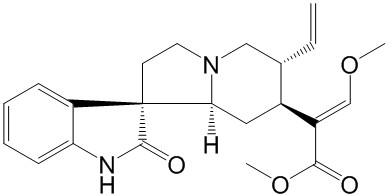Home
Products
Isocorynoxeine



| Product Name | Isocorynoxeine |
| Price: | $143 / 20mg |
| Catalog No.: | CN02074 |
| CAS No.: | 51014-29-0 |
| Molecular Formula: | C22H26N2O4 |
| Molecular Weight: | 382.45 g/mol |
| Purity: | >=98% |
| Type of Compound: | Alkaloids |
| Physical Desc.: | Powder |
| Source: | The herbs of Uncaria rhynchophylla. |
| Solvent: | Chloroform, Dichloromethane, Ethyl Acetate, DMSO, Acetone, etc. |
| SMILES: | CO/C=C([C@H]1C[C@@H]2N(C[C@@H]1C=C)CC[C@]12C(=O)Nc2c1cccc2)/C(=O)OC |
| Contact us | |
|---|---|
| First Name: | |
| Last Name: | |
| E-mail: | |
| Question: | |
| Description | Isocorynoxeine, an isorhynchophylline-related alkaloid, exhibits a dose-dependent inhibition of 5-HT2A receptor-mediated current response with an IC50 of 72.4 μM. |
| Target | 5-HT2A Receptor:72.4 μM (IC50) |
| In Vitro | Isocorynoxeine inhibits 5-HT2A receptor-mediated 5-HT currents. Isocorynoxeine prefer to interact with 5-HT2A receptors rather than with 5-HT2C receptors in the brain.Isocorynoxeine exhibits less potent inhibitory activity (with IC50 values of > 100 μM) against the 5-HT2C receptor-mediated response than the 5-HT2A receptor-mediated response in oocytes. Isocorynoxeine dose-dependently and competitively inhibits 5-HT-evoked currents in Xenopus oocytes expressing 5-HT2A receptors, but has less of a suppressive effect on those in oocytes expressing 5-HT2C receptors[1]. |
| In Vivo | The effects of Rhynchophylline, Corynoxeine, and Isocorynoxeine, isorhynchophylline-related alkaloids present are tested in Uncaria species, on 5-MeO-DMT-induced head-twitch behaviour in reserpinized mice. Neither Rhynchophylline [H=1.369, P=0.504] nor Corynoxeine [H=0.242, P=0.886] affects the behaviour, while Isocorynoxeine significantly attenuates it at 30 mg/kg (i.p.) [H=7.582, P<0.01][1]. |
| Animal Admin | Mice[1] Male ICR mice are pretreated with Reserpine (5 mg/kg, i.p.) 3 h before the start of the experiments. Rhynchophylline (RHY), Corynoxeine (COX), Isocorynoxeine (ICOX, 10 and 30 mg/kg) or vehicle is injected i.p. 30 min before 5-MeO-DMT[1]. |
| Density | 1.3±0.1 g/cm3 |
| Boiling Point | 562.7±50.0 °C at 760 mmHg |
| Flash Point | 294.1±30.1 °C |
| Exact Mass | 382.189270 |
| PSA | 71.36000 |
| LogP | 3.07 |
| Vapour Pressure | 0.0±1.5 mmHg at 25°C |
| Storage condition | -20°C |